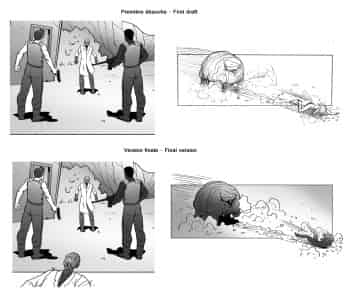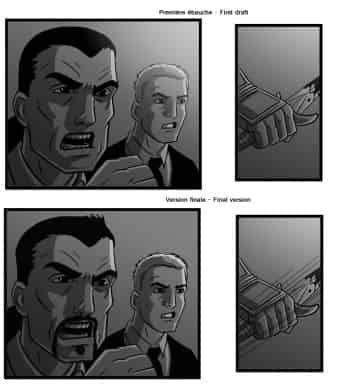Bonus
-
Touch-ups (Freaks) – Part II
Comics are a team enterprise. The writer may ask for changes to an illustration to maintain consistency. For this story were especially concerned with maintaining continuity over the sequence of scenes. So if, for example, Fabien is holding something in his right hand, he can’t then drop it with his right, or if Jason fires a shot using his left hand, he can’t raise the weapon with his right hand in the next panel. We understand the use of ellipses: not everything has to appear in each illustration, but we prefer to maintain an overall consistency.
-
What should we write: what the author wants or what the reader wants?
We came across this analysis about “Man of Steel”:
“Some might look at that scene and ask, “What else could Superman have done?” Others might offer alternative endings to the scene. It’s not a useful conversation. It’s the usual, “Who would win in a fight?” The answer is always that the outcome is determined by the writer, and the story bends to fit that outcome. Superman killed Zod not because there was no other choice, but because the people conceiving the story wanted Superman to kill Zod. (By a majority of two-to-one, according to recent reports.)” (Andrew Wheeler, “Choice and the Moral Universe of Man of Steel’ [opinion],” June 21, 2013, http://comicsalliance.com.)
Several streams of thought collide here. On the one hand, some authors want a kind of integrity for their work, their characters and the story they have been carrying inside them, sometimes for years. Other, more practical, writers just want to be read, and in that case, it may be tempting to turn to tried-and-tested formulas to grab the audience’s attention. The conventional opinion has been that integrity should win over the forces espousing a certain artlessness. However, we believe it’s not the recipe that leads to success but the right proportion of ingredients. And that’s where an author can stand out and give his or her work a personal touch.
-
Touch-ups (Freaks) – Part I
-
Touch-ups (The Auction) – Part III
-
Is there room for subtlety in comic books? Part I
Here’s a key passage from a critique written by Darren about an X-men retrospective dedicated to “Operation Zero Tolerance”: “‘Operation Zero Tolerance’ is, in a word, blunt. With so many of the high-profile comics of the nineties, from both Marvel and DC, ‘subtlety’ is an alien concept. This is an X-Men comic where racial intolerance and prejudice are expressed through nothing short of attempted genocide. On the one hand, it’s very clearly the mutant prejudice idea pushed to its logical extreme. On the other hand, the notion of the United States government even passively condoning an attempted genocide feels like it robs the franchise of the social relevance which had made it so compelling and intriguing.”
But is subtlety really necessary? We’ve read parts of this saga and our biggest beef is that some events happen too fast and with rather tenuous links. But otherwise, it wasn’t a bad comic. (Darren, “X-Men: Operation Zero Tolerance (Review/Retrospective),” July 29, 2013, http://them0vieblog.com)
A few months ago, Jozef Siroka, in a critique of “Man of Steel” went in the other direction: “From Christopher Nolan’s Batman and Daniel Craig’s James Bond, the idea of bringing back earth heroes who used to easily accommodate the fantastic—both witnesses and actors in a world that’s recognizable but entirely fictional—has been largely approved by the public and critics. Critics especially, who were often too quick to equate the realism of the new versions with their artistic quality. Agent 007 and the Black Knight act like adults, and so we, as adults, are grateful. [He adds:] The challenge is to organically integrate the presence of a supernatural character in the natural world.” (Jozef Siroka, «Man of Steel : contre le super-héros «réaliste », June 18, 2013, www.lapresse.ca)
For Siroka, the loss of fantasy comes at the price of a more realistic perspective. So we see that the playfulness of the comic form can become obscured by an overly cerebral approach.







